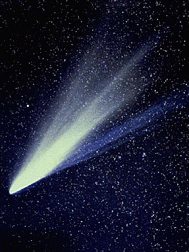![]()
At such times, comets have several distinct parts:
 |
|
This photograph of Comet West was taken by amateur astronomer John Laborde on March 9, 1976. The picture
shows the two distinct tails. The thin blue ion tail is made up of gases, while the broad white tail is made
up of tiny dust particles. (Courtesy John Laborde)
|
When the nucleus is frozen, it can be seen only by reflected sunlight -- so comets are basically invisible. When they are near the Sun, however, a coma develops and everything changes. The dust in the coma reflects sunlight, and gas in the coma absorbs ultraviolet radiation and begins to glow. The comet starts to look like a big "fuzzy ball". This coma material is then blown away from the coma by the solar wind and becomes the comet's tail. Comet tails can stream out up to 100 million km in length! However, the density of material in the tail is not very large. So while you have to prepare your spacecraft to be hit by fast-moving particles, you will only encounter a limited number of them. Exactly how many you will be hit by all depends on how close you get to the nucleus and how active the comet is at the time.
Several mission have flown through a comet's tail and lived to tell about it. The International Sun-Earth Explorer 3 (ISEE-3) spacecraft, renamed the International Cometary Explorer (ICE), made the first ever direct cometary measurements on September 11, 1985 as it flew through the tail of Comet Giacobini-Zinner. The spaceraft encountered a comet ion tail about 25,000 km wide. Water and carbon monoxide ions were identified, which confirmed the "dirty snowball" theory. The ion density increased 100 times over what is usually found in the solar wind. ICE was at a distance of 7,862 km at its closest approach with a flyby velocity of 20.7 km/second. Because the spacecraft did not carry any dust protection equipment, it was expected to suffer some damage during the encounter. However, the spaceraft survived relatively undamaged. Data from the instruments on the spacecraft indicated that it encountered about one dust impact per second, which was lower than expected.
|
Another mission which encountered a comet was called Giotto, after the artist Giotto di Bondone, who had used the appearance of Comet Halley in 1301 as the model for the Star of Bethlehem in his painting titled "Adoration of the Magi". The purpose of the Giotto mission was to study Comet Halley during the comet's trip by the Sun in 1986. On March 13, 1986, Giotto approached Comet Halley to flyby it at a distance of just over 500 km. The spacecraft crossed into the comet's coma. Images from the spacecraft's camera revealed the comet nucleus to be a dark peanut-shaped body with two bright jets spewing material out. Passing by the comet at a velocity of 68 km/second, the spacecraft suffered some damage. Some of the instruments no longer worked or were only partially functional. The star mapper's baffle was peppered with holes. Subsequent analysis of Giotto's data showed that water accounted for about 80% of all of the material being thrown out by the comet. Seven jets were identifed which threw out 3 tons/sec of material. The largest grain detected was 40mg (although it was estimated that a particle between 0.1 to 1 gram hit the spacecraft during the encounter). The data also indicated that the surface of Comet Halley is covered in a layer of organic material. |
Giotto also made a close encounter with Comet Grigg-Skjellerup on July 10, 1992. Aimed directly at the comet, Giotto missed the comet by only 200 km. Flying by at 14 km/second (as opposed to 68 km/sec for Halley), and with a measured dust production rate about 1/200 of Halley's, the Comet Grigg-Skjellerup encounter did very little damage to the spacecraft. But wait...the best is yet to come!
A NASA mission now underway will actually bring back some of a comet's material to Earth for scientists to study. The STARDUST spacecraft blasted off in February of 1999; its destination is the comet Wild 2 (pronounced "vilt 2"). The encounter with Wild 2 will take place in 2004, at a distance of about 400 million kilometers from Earth. During its closest approach to the comet, STARDUST should come within 100 kilometers of the comet nucleus and may have the opportunity to take detailed photographs of surface features. While flying through Wild 2's coma, the spacecraft will make history by capturing materials spewed out from the evaporating nucleus. The spacecraft, with its precious cargo, will then return to Earth in 2006.
![]()
The StarChild site is a service of the High Energy Astrophysics Science Archive Research Center (HEASARC), within the Astrophysics Science Division (ASD) at NASA/ GSFC.
StarChild Authors: The StarChild Team
StarChild Graphics & Music: Acknowledgments
StarChild Project Leader: Dr. Laura A.
Whitlock
Curator:
Responsible NASA Official: